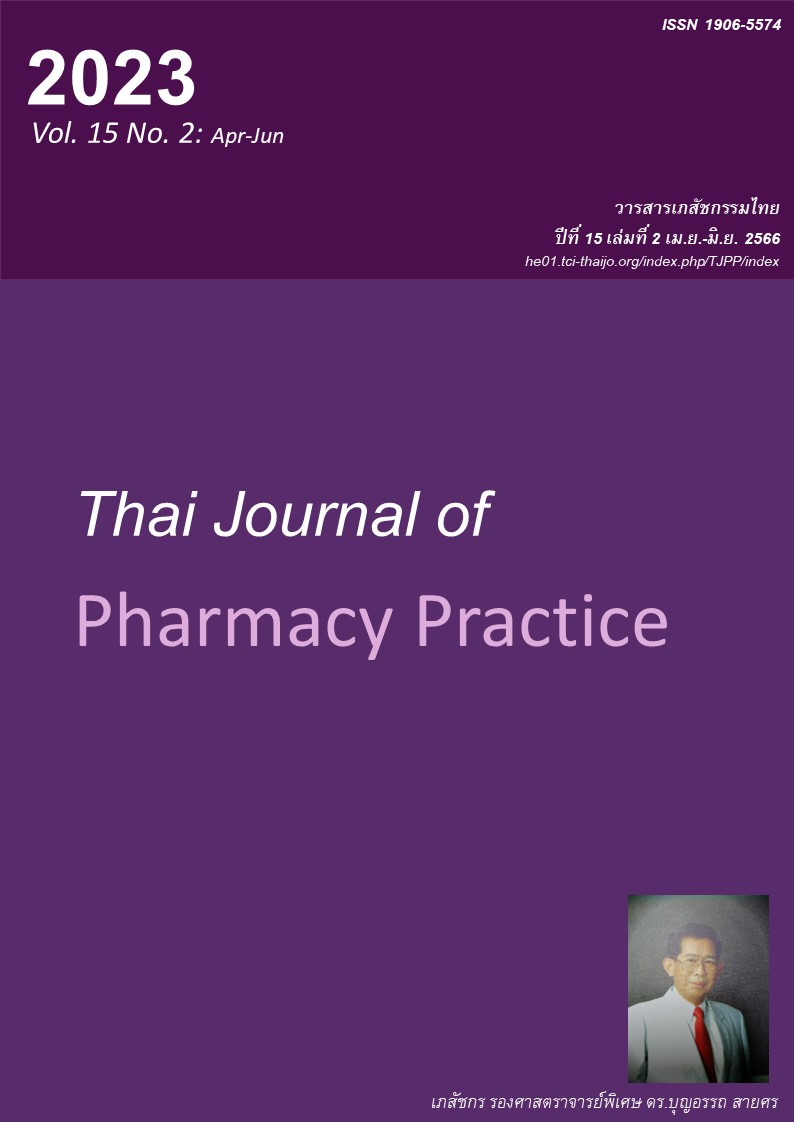ผลของกลไกการเฝ้าระวังผลิตภัณฑ์เสริมอาหารและ เครื่องสำอางที่ไม่เหมาะสมที่จำหน่ายในถนนคนเดินลำพูน
Main Article Content
บทคัดย่อ
วัตถุประสงค์: เพื่อประเมินผลของการเฝ้าระวังผลิตภัณฑ์เสริมอาหารและเครื่องสำอางที่ไม่เหมาะสมที่จำหน่ายในถนนคนเดินลำพูน (การเฝ้าระวังฯ) วิธีการ: การศึกษากึ่งทดลองครั้งนี้พัฒนากลไกการเฝ้าระวังฯ ได้แก่ 1. การคัดกรองผลิตภัณฑ์เสริมอาหารและเครื่องสำอาง (food supplement and cosmetics: FSC) ที่จำหน่ายโดยใช้โปรแกรม Google Sheets 2. การตรวจ FSC โดยเครือข่ายภาคประชาชน 3. การให้ความรู้เกี่ยวกับอันตรายจาก FSC การตรวจ FSC โดยใช้แอพลิเคชั่นไลน์ @FDAThai แก่ผู้ประกอบการจำหน่าย FSC ทุกรายรวม 8 ราย และ 4. การให้ความรู้ในการคุ้มครองตนเองในการบริโภค FSC ให้กับนักเรียนระดับมัธยมศึกษาและอนุปริญญา จำนวน 77 คน การศึกษาเปรียบเทียบความชุกของ FSC ที่ไม่เหมาะสมที่มีการจำหน่าย ความรู้และพฤติกรรมการจำหน่าย FSC ของผู้ประกอบการในถนนคนเดินในช่วงก่อนและหลังใช้กลไกเฝ้าระวังฯ เป็นเวลา 1 เดือน ทั้งยังเปรียบเทียบความรอบรู้ด้านผลิตภัณฑ์สุขภาพและการคุ้มครองตนเองในการบริโภคผลิตภัณฑ์สุขภาพก่อนและหลังจากทำกิจกรรมในวันเดียวกันในกลุ่มนักเรียนฯ ผลการวิจัย: หลังจากการใช้กลไกเฝ้าระวังฯ สามารถลดจำนวนของผลิตภัณฑ์ที่ไม่เหมาะสมจากร้อยละ 5.1 (40/780 รายการ) เป็นร้อยละ 0.5 (3/607 รายการ) (P<0.001) ความรู้เกี่ยวกับ FSC ของผู้ประกอบการเพิ่มขึ้นจาก 11.38±0.92 เป็น 13.25±1.16 คะแนน (P<0.01) และมีพฤติกรรมการตรวจสอบเลขสารบบอาหาร หรือเลขจดแจ้งเครื่องสำอางเพิ่มขึ้นจาก 2 ร้าน (ร้อยละ 25) เป็น 8 ร้าน (ร้อยละ 100) (P=0.031) นอกจากนี้กลไกการเฝ้าระวังฯ ยังช่วยเพิ่มความรอบรู้ด้านผลิตภัณฑ์สุขภาพในด้านการเข้าถึงข้อมูล ด้านความรู้ความเข้าใจ การสื่อสารเกี่ยวกับ FSC และการจัดการตนเองเกี่ยวกับ FSC อย่างมีนัยสำคัญทางสถิติ (P<0.05) และคะแนนการคุ้มครองตนเองในการบริโภคผลิตภัณฑ์สุขภาพในกลุ่มนักเรียนฯ เพิ่มขึ้น จาก 1.74±1.07 เป็น 3.82±0.48 (P<0.01) สรุป: กลไกเฝ้าระวังที่ได้จัดทำขึ้นสามารถลด FSC ที่ไม่ปลอดภัยที่จำหน่ายในถนนคนเดินลำพูนได้ โดยผ่านการใช้การใช้เทคโนโลยีอย่างง่าย เช่น Google Sheets ที่ช่วยคัดกรอง FSC ที่จำหน่าย ทั้งนี้เมื่อร่วมกับการทำงานผ่านเครือข่ายภาคประชาชนในการให้ความรู้แก่ผู้ประกอบการและผู้บริโภคทำให้กลไกเฝ้าระวังมีความเข้มแข็งและมีประสิทธิภาพที่เพิ่มมากยิ่งขึ้น
Article Details

อนุญาตภายใต้เงื่อนไข Creative Commons Attribution-NonCommercial-NoDerivatives 4.0 International License.
ผลการวิจัยและความคิดเห็นที่ปรากฏในบทความถือเป็นความคิดเห็นและอยู่ในความรับผิดชอบของผู้นิพนธ์ มิใช่ความเห็นหรือความรับผิดชอบของกองบรรณาธิการ หรือคณะเภสัชศาสตร์ มหาวิทยาลัยสงขลานครินทร์ ทั้งนี้ไม่รวมความผิดพลาดอันเกิดจากการพิมพ์ บทความที่ได้รับการเผยแพร่โดยวารสารเภสัชกรรมไทยถือเป็นสิทธิ์ของวารสารฯ
เอกสารอ้างอิง
Chattanasenee P. Factor affecting consumers' satifac tion of walking street activities at Tha-Phae road, Chiang Mai province [independent study]. Chiang Mai: Chiang Mai University; 2003.
Office of Lamphun Municipality. Lamphun walking street annual report. Lamphun: Lamphun Municipa- lity; 2019.
Lamphun Municipal Public Health Center. The report on health consumer protection in Lamphun walking street 2019. Lamphun: Lamphun Municipal Public Health Center; 2019.
Eamsiriwong O. Database design and management. Bangkok: Se-Education; 2003.
Food and Drug Administration. Food act B.E. 2522, ministerial regulations, and announcements. Nontha buri Food and Drug Administration; 2014.
Food and Drug Administration. Cosmetics Act B.E. 2558, ministerial regulations, and annoucements. Nonthaburi: Food and Drug Administration; 2015.
Phiboonsrinakrala N, Klinsuntorn N, Pudkum B. Prohibited substance in cosmetic cream: clobetasol propionate. Thai Food and Drug Journal. 2014; 21: 18-23.
Songsilp S. Prevalance of food products with Illegal claims on the labels being sold in flea markets at Loei. Thai Journal of Pharmacy Practice 2019; 11: 151-9.
Kerdsri K, Lerkiatbundit S. Relationship between health literacy and self-protection ability among consumers in health products. Thai Journal of Pharmacy Practice 2018; 10: 239-48.
Sirachote S. Prevalence and prioritization of unsafe drugs, food and cosmetics at pakpanang district, Nakhon Si Thammarat province. Thai Journal of Pharmacy Practice 2020; 12: 354-63.
Tongsukdee S, Nooda N, Vorapani T. Situation and management of cosmetic safety in Sukhothai province. Thai Food and Drug Journal. 2018; 25: 61-71.
Ruenruay S, Saokaew S. Situation of medicines and dietary supplements in the health provider board region 3. Prevalence and prioritization of unsafe drugs, food and cosmetics at pakpanang district, Nakhon Si Thammarat province 2017; 9: 225-35.
Nontagitpaisan W. Development of food surveillance tool for risks of counterfeiting. Nonthaburi: Drug System Monitoring and Development Center. 2017.
Noisanit S, Ruengorn C. Development of a commu nity model with no antibiotics, Yachud and steroids containing Drugs: A case study in Thung Luang subdistrict municipality, khirimat district, Sukhothai. Thai Journal of Pharmacy Practice 2021; 13: 920-32.
Dhanasilangkura W. Management of the problem on cosmetics with prohibited substances by using community participation: A case study of Don-gloy Subdistrict, Phibunrak District in Udon Thani Province. Thai Journal of Pharmacy Practice 2019; 10: 60-8.


